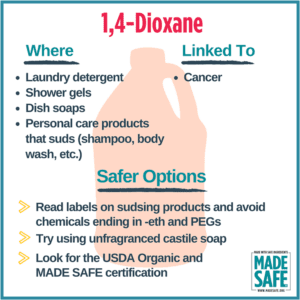
The coalition’s action seeks to support the Biden Administration’s anticipated efforts to correct the many deficiencies in the 1,4-dioxane risk evaluation. The procedures used for chemical risk evaluations under the Toxic Substances Control Act (TSCA) were identified as potentially contrary to President Biden’s Executive Order on Protecting Public Health and the Environment and Restoring Science to Tackle the Climate Crisis (Executive Order No. 13990), and thereby, subject to revision, rescission, or suspension.
“The EPA’s final risk evaluation was flawed and legally insufficient,” said Attorney General Connors. “The EPA has an important mandate, and must implement regulatory measures that keep our communities safe.”
Exposure to 1,4-dioxane poses serious harms to human health, including nervous system effects, liver, kidney, and lung degeneration, and death. EPA classifies 1,4-dioxane as “likely to be carcinogenic to humans.” 1,4-dioxane is widely used, among other things, as a solvent in a variety of commercial and industrial applications. The chemical is also present as a byproduct from the breakdown of other chemicals in a variety of consumer products, including detergents, household cleaners, and personal care products. 1,4-dioxane can be released into the air, water, and soil at places where it is produced or used.
Because of its potential for substantial harm to public healt h and the environment, EPA selected 1,4-dioxane as one of the initial 10 chemical substances subject to its initial risk evaluations required under the TSCA amendments of 2 016. That law requires EPA to perform comprehensive evaluations of the risks associated with the “full range of exposures” people have to the chemical. The coalition argues that EPA’s 1,4- dioxane risk evaluation excludes many significant exposure pathways through which people are exposed to the toxic chemical – such as contaminated drinking water, air, or soil. In fact, the EPA’s risk evaluation under the former administration found no “unreasonable risk” to the general public from 1,4-dioxane’s uses – even though the exposure to the general public examined by the agency was limited to recreational swimming and did not include all the other, more important, ways – including drinking contaminated water – that 1,4-dioxane may harm people’s health.
The coalition also argues that in violating the TSCA and EPA regulations, EPA’s final risk evaluation failed to assess 1,4-dioxane’s exposure risks to “potentially exposed or susceptible subpopulations” – such as infants, children, pregnant women, workers, or the elderly – who may be at greater risk than the general public. Further, EPA’s evaluation underestimated 1,4-dioxane’s risk to workers in commercial and industrial settings based on the unfounded assumption that workers will use personal protective equipment, and that this equipment will protect against 1,4-dioxane exposure. The attorneys general contend that EPA understated the chemical’s risks to workers through these unsupported assumptions.
Before finalizing the 1,4-dioxane risk evaluation, EPA expanded the scope to cover several additional consumer uses, including surface cleaners and laundry/dishwashing detergents. The coalition notes that EPA expanded this scope in line with the urgings of industry trade groups which seek to block related state-level policies. EPA’s subsequent final risk evaluation for 1,4-dioxane found no unreasonable risk to consumers from the chemical in these products.
Joining Attorney General Connors in filing the petition are the attorneys general of Illinois, Maine, Massachusetts, Maryland, Minnesota, New Jersey, Oregon, Pennsylvania, Rhode Island, Vermont, Virginia, Washington, and District of Columbia, as well as the City of New York.
A copy of the petition can be found here.